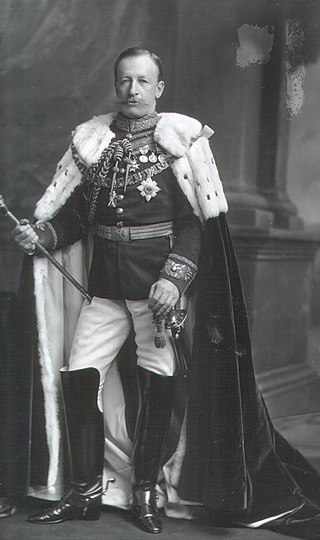Hay is an English and Scottish surname, shortened from the Scoto-Norman de la Haye. A common variation is Hayes, and to a lesser degree Haynes, Haines, or Hughes. Notable people with the surname include:
As aristocratic Scottish family name (see Clan Hay):

Marquess of Tweeddale is a title of the Peerage of Scotland, created in 1694 for the 2nd Earl of Tweeddale. Lord Tweeddale holds the subsidiary titles of Earl of Tweeddale, Earl of Gifford (1694), Viscount of Walden (1694), Lord Hay of Yester (1488), and Baron Tweeddale, of Yester in the County of Haddington (1881), all but the last in the Peerage of Scotland. As Baron Tweeddale in the Peerage of the United Kingdom, Lord Tweeddale sat between 1881 and 1963 in the House of Lords. The Marquess's eldest son uses Viscount Walden as a courtesy title.

Earl of Erroll is a title in the Peerage of Scotland. It was created in 1453 for Sir William Hay. The subsidiary titles held by the Earl of Erroll are Lord Hay and Lord Slains (1452), both in the Peerage of Scotland. The Earls of Erroll also hold the hereditary office of Lord High Constable of Scotland. The office was once associated with great power. The Earls of Erroll hold the hereditary title of Chief of Clan Hay.

Earl of Kinnoull is a title in the Peerage of Scotland. It was created in 1633 for George Hay, 1st Viscount of Dupplin. Other associated titles are: Viscount Dupplin and Lord Hay of Kinfauns (1627) and Baron Hay of Pedwardine (1711). The former two are in the Peerage of Scotland, while the third is in the Peerage of Great Britain. The title of Viscount Dupplin is the courtesy title for the Earl's eldest son and heir.

Field Marshal George Hay, 8th Marquess of Tweeddale, was a British soldier and administrator. He served as a staff officer in the Peninsular War under Arthur Wellesley and was with Wellesley at the Second Battle of Porto when they crossed the Douro river and routed Marshal Soult's French troops in Porto. Hay also saw action at the Battle of Bussaco and at the Battle of Vitoria. He later served in the War of 1812 and commanded the 100th Regiment of Foot at the Battle of Chippawa when he was taken prisoner of war. He went on to become governor of Madras and, at the same time, Commander-in-Chief of the Madras Army, in which role he restored the discipline of the army, which had been allowed to fall into a relaxed state.
John Hay (1838–1905) was an American politician; Secretary of State 1898–1905.
George Hay may refer to:

George Hay, 7th Marquess of Tweeddale DL was a Scottish peer and naval officer.

John Hay, 1st Marquess of Tweeddale was a Scottish peer and politician who served as Lord Chancellor of Scotland.
William Hay may refer to:

Charles Gore Hay, 20th Earl of Erroll, KT, CB, styled Lord Hay until 1891, was a Scottish soldier and Conservative politician.
There have been four baronetcies created for persons with the surname Hay, all in the Baronetage of Nova Scotia. Two creations are extinct, one dormant and one extant. A fifth baronetcy in the Jacobite Peerage, although theoretically extant, is not recognised by the Lyon Office.

Yester Parish Church is a church of the Church of Scotland in the village of Gifford, East Lothian, Scotland. The village forms part of Yester, Bolton and Saltoun parish, and is a linked charge with Humbie Parish Church.

Yester House is an early 18th-century mansion near Gifford in East Lothian, Scotland. It was the home of the Hay family, later Marquesses of Tweeddale, from the 15th century until the late 1960s. Construction of the present house began in 1699, and continued well into the 18th century in a series of building phases. It is now protected as a category A listed building, and the grounds of the house are included in the Inventory of Gardens and Designed Landscapes in Scotland, the national listing of significant gardens.

William Montagu Hay, 10th Marquess of Tweeddale, KT, DL, known before 1878 as Lord William Hay or Lord William Montagu Hay, was a Scottish landowner, peer and politician. He was born at Yester House, near Gifford, East Lothian, and served in British India as a member of the Bengal Civil Service and later as a Liberal Member of Parliament.

William Hay, 4th Earl of Kinnoull was a Scottish peer and soldier, loyal to King Charles I. He escaped twice from Edinburgh Castle.

William Hay, 1st Earl of Erroll was a Scottish peer. He was the first Earl of Erroll and the second Lord Hay of Erroll.
Robert Ker, 3rd Earl of Roxburghe PC was a Scottish nobleman.
William George Montagu Hay, 11th Marquess of Tweeddale JP was a Scottish aristocrat, land owner and soldier.
John Hay, 1st Earl of Tweeddale (1593–1653) was a Scottish aristocrat.